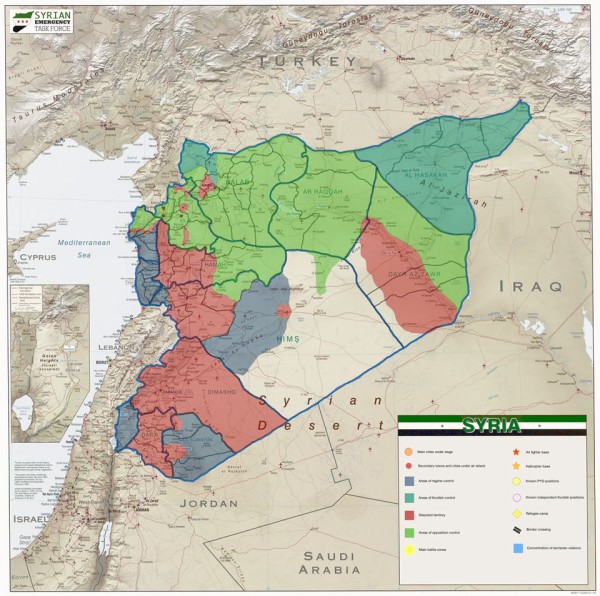
The rapidly escalating conflict in Syria is raising the collective volume of voices asking, “What can and should President Obama do in Syria?” The reality is that Syria’s future is inextricably tied to the future stability of the entire MENA region. Today, I turn to Cassie Chesley, Chair of the Coalition for a Democratic Syria Public Relations Committee & Media Coordinator for the Syrian Emergency Task Force, to explain why ignoring President Obama’s red line will give a green light to a worsening humanitarian and security crisis in the region and beyond. **
Through every step of the Syrian revolution, the Assad regime has tested the international community by slowly but consistently escalating the nature and degree of its attacks against the Syrian people. There is a clear pattern that has surpassed the ubiquitous snipers and checkpoints, first with the introduction of helicopter gunships, then cluster munitions, then SCUD missiles, and now we see the beginning of what every Syrian knows will become widespread use of chemical weapons.
On April 25, Secretary of Defense Hagel publicly confirmed that the chemical weapon (CW) sarin gas was used in Syria, which should have triggered U.S. action in Syria. As the Obama administration begins to consider military action in Syria including arming vetted elements of the Free Syrian Army (FSA), a no-fly zone, and limited military strikes, it is crucial to outline the options and why a clear, timely response to the Assad regime’s use of CW is important. The United States must send a clear, strong message, or a dangerous precedent will be set for the Assad regime and for other “red lines” in the region and beyond. If the United States hesitates, we will see an escalation in widespread use of CW, before a consensus is reached.
The opposition does not seek intervention in Syria that requires American ground troops. The Syrian government has already lost territorial control of 60 percent of the country (see map). Selectively arming vetted elements of the opposition through FSA commander Gen. Salim Idris and the Supreme Military Council, and the creation of a no-fly zone, will both aid the FSA in protecting this territorial control, and protect countless civilians in the liberated areas. A no-fly zone could be achieved as carried out in Libya, or by extension of the Patriot Missiles in Turkey to cover Syrian soil.
An immediate and effective response to Assad’s CW use would be a series of strikes against strategic military sites, not near civilian populations, that house airplanes and missiles, which can even be carried out by unmanned drones. The destruction of missiles capable of carrying chemical weapons would inhibit the regime’s ability to carry out attacks against the civilian population, while signaling to the world that CW use is unacceptable. Additionally, while confirmation of CW is in progress, the United States and others should provide medical equipment, such as Atropine (antidote for sarin/nerve gas), for those experiencing CW symptoms, and equipment to protect against exposure. Relief organizations, such as the Syrian American Medical Society, are treating patients exhibiting symptoms consistent with sarin gas exposure and providing their tissue and blood samples to U.S. government agencies.
The United States must act for moral and national security reasons. As in Rwanda, some are parsing words to excuse inaction. In 1994, the Clinton administration abstained from intervention through a legal loophole, terming the incident an “act of genocide” rather than “genocide,” which would have required international intervention. Failure on the part of the Obama administration to take an immediate stand against the use of CW is a green light for the Assad regime to escalate their use of CW while sending a similar message to Iran.
As the Assad regime has done with conventional weapons, it will escalate to widespread CW attacks if the U.S. does not take strong action now. The use of tactical CW attacks is consistent with the Assad regime’s strategy. The escalation is clear – airstrikes, SCUD missiles, and now small-scale CW attacks. The United States must act now and launch a series of strategic strikes against the Assad regime’s military operations, or else risk further escalation of the conflict and setting a dangerous precedent. Secretary Kerry said “we need to change the calculations of Bashar Al Assad,” and the only means of achieving this is to take serious action now showing Assad and his inner circle that they cannot act with impunity.
Intervention alone does not provide a full solution to the many problems facing Syria. We must acknowledge that the country is in dire need of the utmost international pressure to enter into a negotiated transfer of power, so that its people, with robust international support, can proceed to the difficult tasks of rebuilding and reconciliation that lies ahead. Intervention is needed now to save lives and accelerate the process. —Cassie Chesley